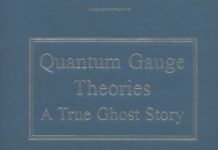
Ebook Info
- Published: 2014
- Number of pages: 432 pages
- Format: PDF
- File Size: 42.40 MB
- Authors: Gunter Scharf
Description
In this classic text for advanced undergraduates and graduate students of physics, author Günter Scharf carefully analyzes the role of causality in quantum electrodynamics. His approach offers full proofs and detailed calculations of scattering processes in a mathematically rigorous manner. This third edition contains Scharf’s revisions and corrections plus a brief new Epilogue on gauge invariance of quantum electrodynamics to all orders. The book begins with Dirac’s theory, followed by the quantum theory of free fields and causal perturbation theory, a powerful method that avoids ultraviolet divergences and solves the infrared problem by means of the adiabatic limit. Successive chapters explore properties of the S-matrix — such as renormalizability, gauge invariance, and unitarity — the renormalization group, and interactive fields. Additional topics include electromagnetic couplings and the extension of the methods to non-abelian gauge theories. Each chapter is supplemented with problems, and four appendixes conclude the text.
User’s Reviews
Reviews from Amazon users which were colected at the time this book was published on the website:
⭐Every book should be reviewed by at least one expert and one beginner. Well, I’m the beginner. The expert will be coming along later.This 2014 revision of a 1989/1995 book by Günter Scharf is apparently trying to fix some of the deep-seated problems of quantum field theory which have put me off the subject since the 1970s. I once asked a mathematical physics lecturer about the logical consistency of quantum field theories. He told me, with no sense of irony, that the only self-consistent relativistic quantum field theory was the case of a vacuum universe. In other words, an empty universe apart from the vacuum. This really put me off the subject altogether. In lectures, we were told about operations with operators which were undefined, and derivatives and integrals which were undefined, and infinities galore which required “renormalization” kludges to make them artificially converge. Then after making so many clearly logically inconsistent assumptions regarding computations with symbols which had no meaning, somehow magically the right answers appeared.I guess physics was always beset by logical inconsistencies and undefined operations. Newton’s gravity theory was based on an ill-defined calculus/geometry hybrid which was only sorted out in the late 19th century, and Fourier analysis for the heat equation was only sorted out a century after it introduced strange new non-differentiable functions and unorthodox kinds of limits of integrals. And the Dirac delta function was sorted out mathematically a decade or two after it was used in physics in logically dubious ways. So maybe one should not be too judgemental about the state of QFT in the last few decades. It seems to me that Günter Scharf is trying to remedy some of the inconsistencies and meaningless operations in QFT with this book. It looks to me like he has had some success, although I am poorly qualified to say this.The author makes his objectives clear in the 2012 preface. This is all in the Amazon preview. It’s well worth reading. I’ll just quote a few sentences here regarding the avoidance of divergences.”However, there is a simple way out which one learns in mathematics.One must only adopt the following two rules.First, use well-defined quantities only, for example free fields.Second, make justified operations only in the calculations;in particular do not multiply certain distributions by discontinuous step functions.If one really follows these rules, then no infinity can appear and life is beautiful.”This seems almost like a statement of the obvious, except that most QED and QFT books continue to use methods which make mathematicians shake their heads in bewilderment. Scharf’s path towards a more rational kind of QED is “the causal method” applied to the S-matrix (defined on page 14). The author says, also in the 2012 preface:”The important point is that this directly leads to the finite (“renormalized”) perturbation series. In fact, no divergent Feynman integral and no ultraviolet cutoff will appear in this book, explaining why the title “Finite QED” was chosen.”Chapter 0 (20 pages) gives preliminary material on the Lorentz group and some definitions of S-matrix and causality concepts for general time-independent Hamiltonians.Chapter 1 (45 pages) is a crash course (or revision) of RQM (Dirac equation) with a gauge potential, followed by a derivation from a Lagrangian via Euler-Lagrange equations, followed by a detailed application to solutions for hydrogen-like atoms.Chapter 2 (93 pages) introduces the Fock space, which is a direct sum of symmetrized or antisymmetrized tensor products of a given general Hilbert space. This permits multiple particles to be represented, as well as pair creation and annihilation. This is applied to quantization of the Dirac field. The S-matrix for the multi-particle Fock space is derived from the single-particle S-matrix, applying causality once again to determine phase.In Chapter 3 (107 pages), both the electron-positron field and the radiation field are quantized. (This is one of the main reasons why I bought this book, namely to find out how both particles and the field can be quantized together.) Ultraviolet divergences are avoided in perturbation series by approximating step functions by smooth functions and taking limits. The computations and concepts in Chapter 3 are a bit overwhelming for a beginner like me. Hopefully an expert will review it, and also Chapter 4 (72 pages), Chapter 5 (41 pages) and Chapter 6 (7 pages).Apart from the final Chapter 6, this book avoids non-Abelian gauge theories. It’s strictly about QED. But it is clear that this is not a beginner’s book. You need to have a really good grounding in standard QED theory before starting on this book.The approach taken in this book is related to the approach taken in the same author’s ”
⭐”, which apparently arrives at a solution to the dark matter problem in a novel way by making the metric tensor of general relativity into a spin-2 field on a flat Minkowski space-time.
⭐Have to see his point of view
⭐QFT is a difficult subject, and having a pedagogically sound approach is extremely important. Students should be less affected by tediousness than by vagueness. Finite QED is methodologically sound.
⭐Wonderful book on QED!
Keywords
Free Download Finite Quantum Electrodynamics: The Causal Approach, Third Edition (Dover Books on Physics) in PDF format
Finite Quantum Electrodynamics: The Causal Approach, Third Edition (Dover Books on Physics) PDF Free Download
Download Finite Quantum Electrodynamics: The Causal Approach, Third Edition (Dover Books on Physics) 2014 PDF Free
Finite Quantum Electrodynamics: The Causal Approach, Third Edition (Dover Books on Physics) 2014 PDF Free Download
Download Finite Quantum Electrodynamics: The Causal Approach, Third Edition (Dover Books on Physics) PDF
Free Download Ebook Finite Quantum Electrodynamics: The Causal Approach, Third Edition (Dover Books on Physics)

